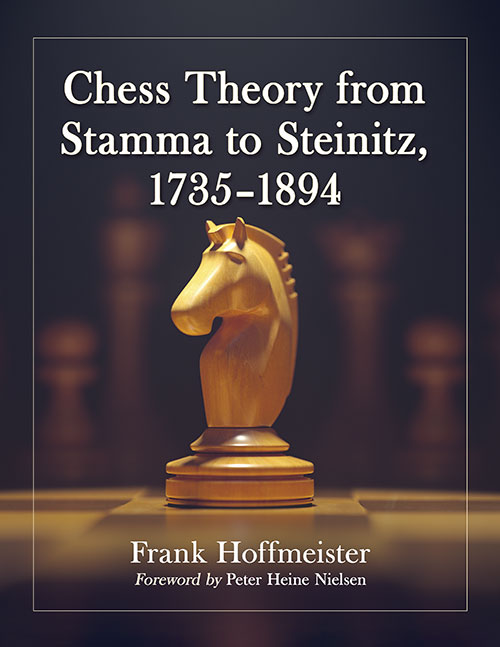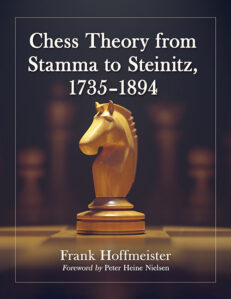Chess Theory from Stamma to Steinitz, 1735–1894
Original price was: $99.00.$79.99Current price is: $79.99.
In stock
About the Book
Most chess biographies present the games of famous players—but not their writings. Filling that gap, this book begins with Syrian master and author of chess studies Philip Stamma, and finishes with the first world champion William Steinitz. The main novelties in opening, middlegame and endgame theory in the 160 year period are examined and biographical sketches put the contributions of more than 30 masters into context.
The author presents many new insights—for example, regarding the origins of the Ponziani Opening, the Dutch Defense and the Petroff Defense. French star La Bourdonnais used other sources for almost every part of his Nouveau Traité. Morphy’s analysis of the Philidor Defense was faulty and Anderssen’s play included many positional ideas. Harrwitz and Neumann published modern treatises long before Steinitz came out with his Modern Chess Instructor. Many ending themes belong to less well-known authors, such as Cozio, Chapais, van Zuylen van Nyevelt, Sarratt, Kling and Horwitz, Berger and Salvio.
About the Author(s)
Bibliographic Details
Frank Hoffmeister
Foreword by Peter Heine Nielsen
Format: library binding (8.5 x 11)
Pages: 492
Bibliographic Info: 83 illustrations, 407 diagrams, appendices, bibliography, index
Copyright Date: 2022
pISBN: 978-1-4766-8071-2
eISBN: 978-1-4766-4456-1
Imprint: McFarland
Table of Contents
Acknowledgments vi
Abbreviations Used in This Book x
List of Game and Puzzle DIAGRAM Numbers xi
Foreword by Peter Heine Nielsen 1
Introduction 3
I. From Bertin to Del Rio (1735–1775)
A. The Time 5
Old Arab Puzzles and New Opening Ideas 5
Philidor Versus the Italian School 6
B. The Players 7
Joseph Bertin (ca. 1690–1736) 7
Philip Stamma (ca. 1700–1755) 13
Carlo Francesco Cozio (ca. 1715–ca. 1780) 20
François-André Danican Philidor (1726–1795) 31
Giambattista Lolli (1698–1769), Domenico Ponziani (1719–1795) and Ercole del Rio (1718–1802) 43
C. The Legacy 53
II. From Allgaier to McDonnell (1775–1835)
A. The Time 56
The French Amateurs and Their Traité 56
Elias Stein (1748–1812) and His Nouvel Essai 58
Philip Julius Count van Zuylen van Nijevelt (1743–1826) and His Superiorité aux Echecs 62
The Chess Automaton 63
Clément Felix Brossier Montigny (1786–1840) and His Stratagèmes des Echecs 66
Jacob Henry Sarratt (ca. 1772–1819) and His Treatise 68
Alexandre Louis Honoré Lebreton Deschappelles (1780–1846) and His 1821 Matches 69
John Cochrane (1798–1878) and His Treatise on the Game of Chess 71
The Friendly Match Between Lewis and La Bourdonnais 73
The 1834 Match Between La Bourdonnais and McDonnell in London 74
B. The Players 77
Johann Baptist Allgaier (1763–1823) 77
William Lewis (1787–1870) 84
Louis Charles Mahé de La Bourdonnais (1797–1840) 97
Alexander McDonnell (1798–1835) 110
C. The Legacy 116
III. From Petroff to Staunton (1835–1850)
A. The Time 118
The Unsuccesful Challenge from Deschapelles to England 1836 118
Aaron Alexandre (1766–1850) and His Encyclopedia 118
George Walker (1809–1879) and His New Treatise on Chess 119
The 1843 Match Between Saint-Amant and Staunton in Paris 122
Lionel Adalbert Bagration Felix Kieseritzky (1806–1853) and His Gambit 125
The Development of Chess in Italy 129
The Development of Chess in Germany 129
The Development of Chess in the Austrian Empire 133
The Development of Chess in Russia 134
B. The Players 136
Alexander Dmitrievich Petroff (1794–1867) and Carl Ferdinand von Jaenisch (1813–1872) 136
Tassilo von Heydebrand und der Lasa (1818–1890) 152
Pierre Charles Fournier de Saint-Amant (1800–1872) 161
Howard Staunton (1810–1874) 168
C. The Legacy 175
IV. From Anderssen to Morphy (1851–1859)
A. The Time 178
London 1851 178
The Chess Studies from Josef Kling (1811–1876) and Bernhard Horwitz (1807–1885) 182
The First Indian Openings 183
The 1853 Match Between Löwenthal and Harrwitz in London 186
Max Lange (1832–1899) and His Attack 188
Manchester 1857 191
New York 1857 192
The 1858 Match Between Löwenthal and Morphy in London 194
John Owen (1827–1901) and His Defense 195
Birmingham 1858 196
The 1858 Match Between Morphy and Harrwitz in Paris 198
The 1858-1859 Match Between Morphy and Anderssen in Paris 198
B. The Players 201
Karl Ernst Adolf Anderssen (1818–1879) 201
Daniel Harrwitz (1821–1884) 208
Johann Jacob Löwenthal (1806–1874) 217
Paul Charles Morphy (1834–1884) 223
C. The Legacy 233
V. From Paulsen to Neumann (1860–1871)
A. The Time 235
The 1860 Match Between Kolisch and Anderssen in Paris 235
The 1861 Match Between Kolisch and Anderssen in London 236
Bristol 1861 237
The 1861 Match Between Kolisch and Paulsen in London 238
London 1862 239
Serafino Dubois (1817–1899) and His Defense of Italian Chess Rules 240
The 1862 Match Between Paulsen and Anderssen in London 242
Jean Louis Préti (1798–1881) and His Stratégie Raisonnée des Ouvertures 242
Robert Bownas Wormald (1834–1876) and His Chess Openings 246
The 1866 Match Between Anderssen and Steinitz in London 248
Paris 1867 252
Dundee 1867 253
Baden-Baden 1870 254
B. The Players 257
Louis Paulsen (1833–1891) 257
Ignaz Kolisch (1833–1889) 265
Gustav Richard Ludwig Neumann (1838–1881) 271
C. The Legacy 279
VI. From Rosenthal to Zukertort (1872–1885)
A. The Time 281
London 1872 281
The 1872 Match Between Steinitz and Zukertort in London 282
Vienna 1873 283
William Cook (1850–1917) and His Synopsis of Chess Openings 285
The 1876 Match Between Steinitz and Blackburne in London 287
Leipzig 1877 288
Paris 1878 289
The 1880 Match Between Zukertort and Rosenthal in London 290
Wiesbaden 1880 291
The 1881 Match Between Zukertort and Blackburne in London 292
Berlin 1881 293
Vienna 1882 294
London 1883 297
Nuremburg 1883 298
Hamburg 1885 299
Horatio Caro (1862–1920) and His Defense 299
Carlo Salvioli (1848–1930) and His Teoria e Pratica degli Scacchi 301
B. The Players 303
Samuel Rosenthal (1837–1902) 303
Szymon Abramowicz Winawer (1838–1919) 311
Joseph Henry Blackburne (1841–1924) 318
Johannes Zukertort (1842–1888) 328
C. The Legacy 336
VII. From Steinitz to Chigorin (1886–1894)
A. The Time 338
The 1886 World Championship Match Between Steinitz and Zukertort in the United States 338
London 1886 340
George Henry Mackenzie (1837–1891) and His Triumph at Frankfurt 1887 341
The 1889 World Championship Match Between Steinitz and Chigorin in Havana 343
New York 1889 346
Breslau 1889 347
Amsterdam 1889 348
The Chess Openings Ancient and Modern from Edward Freeborough (1830–1896) and Charles Ranken (1828–1905) 349
Johann Nepomuk Berger (1845–1933) and His Theorie and Praxis der Endspiele 352
The 1890 Match Between Chigorin and Gunsberg in Havana 353
Manchester 1890 355
The 1890-1891 World Championship Match Between Steinitz and Gunsberg in New York 356
The 1892 World Championship Match Between Steinitz and Chigorin in Havana 358
The 1892 Match Between Blackburne and Lasker in London 359
Dresden 1892 360
The 1893 Match Between Tarrasch and Chigorin in St. Petersburg 361
Curt von Bardeleben (1861–1924) and His Wiener Partie 363
The 1894 World Championship Match Between Steinitz and Lasker in the United States 365
James Mason (1849–1905) and His Principles of Chess 368
Henry Edward Bird (1829–1908) and His Chess Novelties 370
B. The Players 374
Wilhelm Steinitz (1836–1900) 374
Isidor Arthur Gunsberg (1854–1930) 389
Amos Burn (1848–1925) 397
Mikhail Ivanovich Chigorin (1850–1908) 404
C. The Legacy 418
VIII. Conclusion
Theory and Practice 420
Openings 422
Middlegame 427
Endings 430
Blindfold Chess, Chess Composition and Odds Games 431
Chess Personalities 432
Presentation of Chess Games 434
Chess Nations 434
Appendices:
1: Overlap of Puzzles Between Bertin, Stamma, Cozio and Lolli 439
2: Overlap of Puzzles Between Montigny and Others 441
3: Overlap of Puzzles Between Allgaier’s Neue theoretische Anweisung and Others 446
4: Overlap of Puzzles Between La Bourdonnais and Others 448
5: Overlap of La Bourdonnais’ Nouveau Traité with Montigny’s Cleveland Manuscripts 451
6: Overlap of Endings Between La Bourdonnais’ Nouveau Traité, Philidor’s Analyse and the Traité des Amateurs 452
7: Overlap of Puzzles Between Petroff and Others 454
8: Milestones of Algebraic Notation in the 19th century 456
9: The Use of First Names and the Spelling of Family Names 457
Bibliography 459
Openings Index (to Diagram Numbers) 467
General Index (to Page Numbers) 468
Book Reviews & Awards
• Honorable Mention, Book of the Year Award—Chess Journalists of America
• “[A] monumental work…Through a meticulous examination of developments in chess over the 160 years…the author provides invaluable insight into frequently overlooked contributions which form the core of so much of what we think we know today…Hoffmeister has performed an immeasurable service to all interested in chess by rendering that foreign country recognizable and even familiar.”—British Chess Magazine
• “Excellent…well illustrated…a necessary purchase for any chess library.”—Kingpin Chess Magazine





